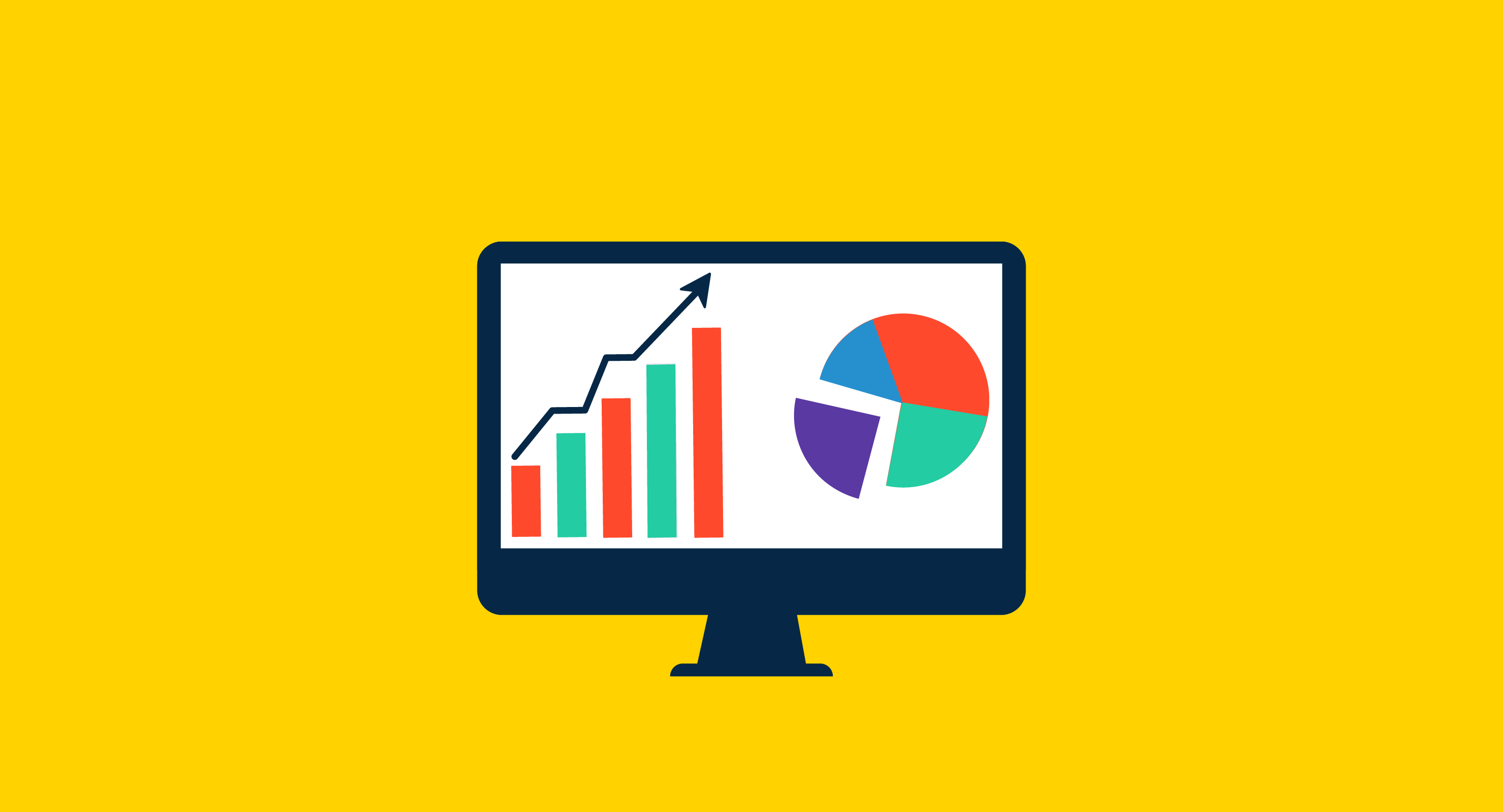July 10, 2025
 by Guy Rubin / July 10, 2025
by Guy Rubin / July 10, 2025

Every meaningful business outcome starts with one thing: understanding your customers better. Whether it’s marketing that resonates, sales that consistently close, or customer service that solves problems before they escalate, it all hinges on insight.
The good news? The foundation for that insight is already at your fingertips: it’s sitting inside your CRM.
Your CRM software holds a goldmine of customer data: contact info, past purchases, sales conversations, support tickets, and more. But unless you’re actively analyzing that data, it’s just digital clutter. CRM analytics changes that by turning raw records into insights you can use to drive revenue, build loyalty, and fine-tune your strategy.
The global CRM market is estimated to be worth $73.4 billion in 2024, with projections indicating it could grow to approximately $163.2 billion by 2030, reflecting a compound annual growth rate (CAGR) of 14.6% between 2025 and 2030. That stat alone shows how important it’s become to turn customer data into action, not just store it in your software.
CRM analytics is the process of analyzing customer relationship management data to improve sales, marketing, and customer service strategies. It uses tools to track customer interactions, identify trends, and predict behavior. Businesses use CRM analytics to increase customer retention and optimize marketing campaigns.
It’s no secret that it takes more than one positive interaction with a customer to win them over. Earning their loyalty and trust requires understanding - if you don’t have a good idea of who they are, what they want, and the problems they’re trying to solve, then how can you expect to meet their needs?
The sheer amount of data held within your CRM software is a goldmine of customer insights, enabling businesses to tailor their strategies effectively. While some of it might seem mundane, like contact information and interactions with reps, everything can be used to nurture that mutually beneficial relationship between you and your customers.
While there are specific functions a CRM should provide in order to work well, another side of its functionality is providing data and analytics. Business analytics is the foundation for successfully converting leads into customers and customers into brand advocates.
Here are a couple of examples of how CRM analytics can make that happen for your business.
With the best customer data platforms, you can lay out a clear customer journey for your business to follow and act upon.
Every customer goes through a journey, starting when they don’t even know your business exists, to the moment they pay an invoice and become brand advocates.
When buying impulsively, the entire journey happens almost instantly. But when it comes to large purchase decisions, the customer's journey will be significantly longer, include various decision-makers, and require multiple conversion points. For example, if a business is thinking about investing in a new software tool, they would conduct primary research, collect and review proposals, and consult key stakeholders.
When dealing with a process that can take months, it’s important to have software in place that can give sales and marketing team members the ability to manage the customer's journey all the way to close (and beyond). The right CRM software will look at the areas of the customer journey where buying signals occur and track key metrics that a business needs to understand satisfaction rates. These data points are then analyzed to reveal methods that businesses can implement to improve their processes for selling and nurturing customer relationships.
As pointed out in the examples above, there are key indicators in the process of a buyer's journey that indicate a desire to move from disinterest to purchasing your product or service. This transition is mirrored in any type of customer transaction.
Your CRM should provide easy access to analytics dashboards and CRM reporting features that showcase these indicators and how they impact the business and forecasting. When a business is considering purchasing a solution, the seller’s CRM should track key items like website visits, touchpoints, social media engagements, if forms are filled out, if webinars or other events were attended, and more.
On their own, these items might not mean anything, but the right analytics will show trends among certain customers based on the frequency or significance of their engagement.
CRM analytics can also provide insight into customer satisfaction by picking up both positive and negative signals based on their actions.
Tracking things like open cases, inbound and outbound calls, and conversation subject matter can all reveal if a certain customer is getting their money’s worth, or running into issue after issue. A customer opening a case to complain about a product issue sends an entirely different signal than a customer using that same form to renew their contract.
Both actions require a response from your team, but different types. In the first situation, your team needs to make it right through customer service. In the second situation, your team could follow up with opportunities to upsell or cross-sell. Either way, analyzing those signals will offer data that assists in making efforts to further satisfy or retain customers.
Another way CRM analytics can help your business is through predictive modeling, which is the process of predicting outcomes using data. By analyzing custom data, businesses can accurately determine the likelihood of success or failure of a future endeavor. Essentially, it offers a glimpse into the future should a certain action be taken, allowing businesses to mitigate the associated risks.
To use predictive modeling effectively, a company must have access to as much customer data as possible - analyzing the results of interactions from 100 customers is a lot more effective and insightful than doing the same thing with just three. Luckily, your CRM holds all of the information you should need to unlock those insights.
Last but not least, CRM analytics can help your business divide customers into different segments.
Especially if your business is still in the process of scaling up to where you want it to be, you might be thinking that you only have one customer base - the one that buys your solution. While they all have that one trait in common, splitting them up further and putting them into different buckets can help you sell to them more efficiently.
Using CRM analytics to group customers together based on traits and actions, like the customer’s role, industry, purchasing history, and support requests can help you market your product and sell to them better.
Building great customer relationships is about more than sending follow-up emails or logging deals; it’s about having the right CRM software to keep your entire customer journey organized. Whether you’re tracking sales, managing support conversations, or analyzing marketing campaigns, a great CRM helps your team work smarter, not harder.
On G2, you’ll find honest reviews from real users who’ve used CRM platforms to boost their customer engagement, streamline sales processes, and drive business growth. You can also check out this guide to evaluating the best CRM software, which breaks down each tool’s pros and cons to help you choose the right fit.
CRM analytics isn’t just about generating reports, it’s about creating real business impact across teams. Here’s a quick snapshot of the key benefits you’ll unlock by making customer data part of your decision-making process:
| Benefit | What it means for your business |
| Clearer customer journeys | Map and optimize every stage of your customer funnel. |
| Improved sales forecasting | Use lead trends to predict revenue outcomes. |
| Higher retention rates | Identify and address customer satisfaction gaps. |
| More efficient lead management | Prioritize leads with the highest conversion potential. |
| Personalized marketing | Segment audiences and tailor campaigns to their needs. |
| Predictive insights | Forecast future customer actions to reduce churn. |
When teams have this level of insight at their fingertips, they can move faster, work smarter, and build customer relationships that last.
CRM analytics isn't just theoretical; it's a proven revenue driver delivering tangible results for leading brands.
Zendesk integrated advanced analytics into its support platform, enabling businesses to gain deeper insights into customer interactions and internal workflows. This integration allowed for more productive conversations at crucial moments, leading to improved customer satisfaction and retention.
HubSpot leveraged AI to transform its email marketing strategy. By analyzing user behavior and segmenting leads, they personalized email workflows, resulting in an 82% increase in conversion rates. This approach underscored the power of data-driven personalization in marketing campaigns.
Reaping the benefits of CRM analytics requires more than just using a customer relationship management tool. The data it holds must be continuously collected, tracked, and managed.
These business processes are more than just the technical functions of the software you use. When starting with CRM data management and analytics, you need to start by educating users and implementing automation where possible.
Employees are the most valuable tool in CRM implementation. The best software in the world is only as good as the people using it. Training employees on data management, proper use of the software, and the sales and marketing processes it serves is a must.
Employees and management also need to be trained in data and analytics reports. Their training needs to demonstrate how the information they have can help them better serve current customers, gain new customers, and ultimately earn more business.
Without a good understanding of how the data will be used, users might start cluttering your CRM with invaluable data. Avoid this by defining workflows, establishing processes, and make it clear what “good data” looks like within a CRM.
When educating your employees, emphasize sales and marketing alignment through cross-departmental communication and collaboration. Sales is not the only department that contributes to attracting and retaining customers. Marketing and customer service play a serious role as well.
“Bringing those three elements under one roof is the only way forward if you want to break silos and learn from other departments.”
Max van den Ingh
Head of Growth at POP
A key factor in managing CRM data is implementing automation wherever you can. Human error happens - details are missed, data is entered incorrectly, and account information can fall out of date. Not only can automation help you avoid these mistakes, but it also opens up a lot more time for sales reps to focus on the customer at hand, rather than their data.
While your business’s automation needs are unique, these actions should be designed to reduce the steps that occur within a customer interaction. If a customer fills out a form on your website signifying they need help, automation should take the form from the website, record the request under the customer's file in your CRM, and send a notification to that rep alerting them that action is required.
The dashboards you use to deliver this information are incredibly important. Customer information has a large impact on the sales and service process, so the data contained in the dashboard needs to be properly interpreted by everyone involved.
Your CRM analytics dashboard is the go-to place for information for customer-facing departments. It’s crucial to ensure that it’s displaying key data points that will guide those departments as they navigate customer relationships.
If you’re looking for some guidance on how to track CRM KPIs, here are some metrics to focus on both before and after a sale is made.
Similar to the tasks you automate, the metrics you track will be unique to your business,current goals, and objectives. You might add some more along the way, but this list is a good place to start.
These metrics help your team measure pipeline health, lead quality, and sales process effectiveness.
These metrics measure the health of your customer base, retention efforts, and expansion opportunities.
These CRM analytics metrics aren’t just numbers,. they’re insights your team can use to optimize customer journeys, personalize outreach, and drive long-term growth. Regularly review these KPIs in your CRM dashboards to identify what’s working and where adjustments are needed.
Have more questions? Find the answers below.
The benefits of CRM analytics include improved customer retention, better sales forecasting, and more effective marketing campaigns. CRM analytics helps businesses identify customer trends, personalize communications, and increase lifetime value. It enables teams to optimize decision-making using real-time customer data and predictive insights.
Track metrics in CRM analytics such as customer acquisition cost (CAC), customer lifetime value (CLV), churn rate, conversion rate, and sales cycle length. Also monitor lead response time, engagement rates, and customer satisfaction scores. These metrics help optimize sales performance, marketing ROI, and customer retention.
CRM analytics improves sales performance by identifying high-value leads, predicting customer behavior, and optimizing sales processes. It tracks conversion rates, monitors sales cycle length, and highlights pipeline bottlenecks. Sales teams use these insights to prioritize prospects, personalize outreach, and close deals more efficiently.
An example of CRM analytics in action is a company using customer purchase history to create targeted email campaigns. By analyzing past buying patterns, the company segments customers and sends personalized offers. This approach increases open rates, improves conversions, and boosts repeat purchases.
Small businesses can use CRM analytics to improve customer engagement, streamline sales processes, and increase revenue. Affordable CRM tools provide analytics features like customer segmentation, lead tracking, and sales forecasting. These insights help small businesses make data-driven decisions and compete effectively with larger companies.
CRM analytics does not always require technical skills because modern CRM platforms offer user-friendly dashboards and automated reports. Basic analytics functions like tracking KPIs and segmenting customers are accessible without coding. However, advanced analysis such as custom queries and data integration may require technical expertise.
Implementing a CRM into your sales strategy is a step in the right direction. However, starting to analyze the data within it using CRM analytics turns that step into a giant leap.
Using the associated data-driven techniques to gain an understanding of your customers and unlock insights into how to sell to them better is beneficial for both parties. Your customers feel valued, and you retain their business. It’s a win-win.
Check out the different types of data visualization to showcase your CRM analytics in an easy-to-digest format.
This article was originally published in 2020. It has been updated with new information.
Event tech providers had it easy. Too easy, in fact.
 by Jose Bort
by Jose Bort
Slack is changing how companies communicate with their employees and help their customers.
 by Joydeep Sen Sarma
by Joydeep Sen Sarma
You know that feeling when you're talking to your customer, and things are going really well?
 by Sharjeel Ahmed
by Sharjeel Ahmed
Event tech providers had it easy. Too easy, in fact.
 by Jose Bort
by Jose Bort
Slack is changing how companies communicate with their employees and help their customers.
 by Joydeep Sen Sarma
by Joydeep Sen Sarma


